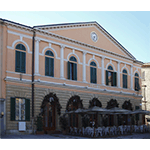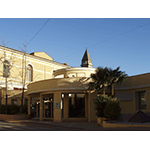Thermal Baths of Casciana
The Baths of Casciana, known already to the Romans, took on new life in the 11th century thanks to Matilde di Canossa, who, it seems, benefited by their curative properties. In 1311 the Podestà of Pisa, Federico da Montefeltro, had a real thermal establishment built. An interesting description of the waters is found in the Tractatus de Balneis (1417) by Ugolino da Montecatini, who resided in Pisa for many years. He visited both Casciana and San Giuliano, and of these places he had "long experience". The waters of Casciana, wrote Ugolino, "are highly beneficial to weak persons and for treating disorders of the digestive system".
The baths were rebuilt in 1621, but later underwent a period of decline. In 1742, in fact, Giovanni Targioni Tozzetti noted that "in the waters of these neglected baths, many frogs live happily". Various remodelling initiatives were carried out, first by Grand Duke Peter Leopold, around 1780, and then by his successor Ferdinand III, in 1824. In the 19th century – as reported by Emanuele Repetti – there were "two large baths, for the two sexes, in the midst of the ancient crater flanked by spacious calidariums". The discharge of the water was also used to drive millstones owned by the Bishops of Volterra. In 1826 the Florentine chemist Giuseppe Gazzeri subjected the waters to chemical analysis. Like many other thermal centres in Tuscany, Casciana flourished in the late 19th century and the early 20th, when it was known by the glamourous name of "Italy's thermal pearl". Still today the Baths of Casciana are a renowned centre of wellness and thermal treatments.
****************************
Texts by Graziano Magrini
English translation by Catherine Frost
Last update 15/feb/2008





